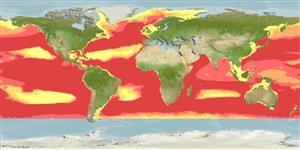Common names from other countries
>
Lophiiformes (Anglerfishes) >
Ceratiidae (Warty Seadevils)
Etymology: Cryptopsaras: Greek, kryptos =secret, hidden + Greek, psaras = fisherman (referring to this genus' tiny illicial bone, almost entirely covered by tissue of the esca) (Ref. 86949); couesii: Named for the eminent ornithologist Elliot Coues (Ref. 4525).
More on author: Gill.
Environment: milieu / climate zone / depth range / distribution range
Ecologie
marien bathypelagisch; diepte 0 - 3085 m (Ref. 58018), usually 500 - 1250 m (Ref. 36494). Deep-water; 81°N - 52°S, 180°W - 180°E
Circumglobal: tropical and subtropical.
Grootte / Gewicht / Leeftijd
Maturity: Lm ? range ? - ? cm
Max length : 7.3 cm TL mannelijk / geslacht onbekend; (Ref. 4494); 44.0 cm TL (female)
Korte beschrijving
Determinatiesleutels | Morfologie | Morfometrie
Dorsale stekels (totaal) : 1; Dorsale zachte stralen (totaal) : 4 - 5; Anale stekels: 0; Anale zachte stralen: 4; Wervels: 20. A large median and two small lateral oval caruncles immediately in front of origin of dorsal fin (Ref. 13608). Branchiostegal rays: 6 (Ref. 36494).
Males dwarfed, becoming parasitic on females. Maximum size of free-living males is 1.05 cm (Ref. 4494). Females are oviparous, with planktonic larvae (Ref. 36494). Eggs are presumably contained in floating gelatinous rafts (Ref. 36494 ).
Females are oviparous, males are parasitic (Ref. 36494).
Bertelsen, E., 1990. Ceratiidae. p. 510-512. In J.C. Quero, J.C. Hureau, C. Karrer, A. Post and L. Saldanha (eds.) Check-list of the fishes of the eastern tropical Atlantic (CLOFETA). JNICT, Lisbon; SEI, Paris; and UNESCO, Paris. Vol. 1. (Ref. 4494)
Status op de Rode Lijst van het IUCN (Ref. 130435)
CITES (Ref. 128078)
Not Evaluated
Gevaar voor de mens
Harmless
Gebruik door de mens
Visserij: van geen belang
Tools
Speciale rapporten
Download XML
Internetbronnen
Estimates based on models
Preferred temperature (Ref.
115969): 2.8 - 10.4, mean 5.6 (based on 2308 cells).
Fylogenetische diversiteitsindex (Ref.
82804): PD
50 = 1.0625 [Uniqueness, from 0.5 = low to 2.0 = high].
Bayesian length-weight: a=0.01995 (0.00906 - 0.04395), b=3.01 (2.83 - 3.19), in cm Total Length, based on all LWR estimates for this body shape (Ref.
93245).
Trofisch niveau (Ref.
69278): 4.5 ±0.37 se; based on food items.
Weerstandsvermogen (Ref.
120179): Gemiddeld, minimale populatieverdubbelingstijd 1,4-4,4 jaar (tm=5).
Fishing Vulnerability (Ref.
59153): Low to moderate vulnerability (34 of 100).
